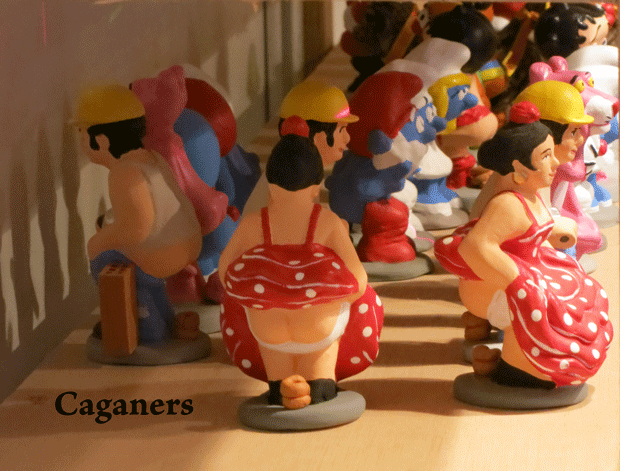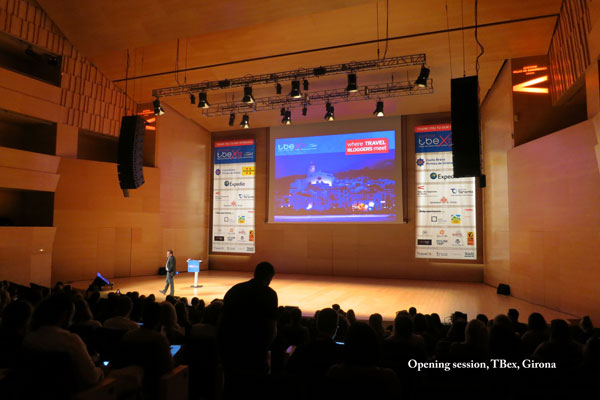The Risks of Time Travel in Santa Fe
by Elyn Aviva
We punched in the entry code on the keypad on the side of the looming concrete storage building, opened the door, and walked down the empty, darkened corridors to our numbered unit. We unlocked the roll-up metal door and pushed it up, revealing a colorful hodgepodge of items stacked along the walls and piled on metal shelving units in the center. We were entering a mysterious domain, a mixture of refuse dump and Treasure Island.
This was the stuff we had left behind six years ago in Santa Fe, New Mexico, when my husband, Gary, and I moved to Spain. Now that were happily settled as expats in Girona, Catalonia, Spain, the time had come to clear out the storage unit. No more excuses.
Misled on St Michael’s Way, Cornwall
by Elyn Aviva
It took nearly 11 years and three attempts for my husband, Gary, and me to complete the 12-mile-long St Michael’s Way across the southern tip of Cornwall. That’s a rather long time for a short walk—probably a record of some sort. And even though we ended up hiking more than 12 miles, we never did manage to walk the middle five.
But we persevered, although we were misled every step of the way.
Where in Girona Am I?
I am sitting in a chair on our fifth-floor terrace, looking out over the Onyar River to the hills and the Old Town of Girona. I can see tour groups starting to arrive. A queue of impatient visitors and uniformed school children is forming at the stone bridge, waiting for the shiny red “City Tour Train” to appear and transport them effortlessly through the winding streets.
It is the 60th Temps de Flors, the annual Girona flower festival held in early May. Tens of thousands of people jam the narrow cobblestone streets and stair-stepped alleys of the Old Town, admiring the profuse floral displays that adorn the private patios, gardens, and buildings normally closed to the public. The air is fragrant with flowers, their themes and textures as varied as the artists who design the installations.
My husband, Gary, and I recently went to Cornwall to walk meandering paths with a small group. At least, thatwas the story. One morning over breakfast at Rosemerryn House in Lamorna Valley, one of our group revealed she is a professional storyteller. She described learning to take storytelling seriously. “After all,” she mused, “We don’t usually think stories are important. At least, not in the real world.”
I realized that often the word “story” is used as a code word for “false.” As in: “Oh, that’s a likely story! You don’t really expect me to believe you, do you?” Or it’s trivialized to mean something soothing, as in, “Tell me a bedtime story.” Of course, a story is much more than that: it is how we make meaning out of our experiences—as in, “telling the story of my life.” Sometimes I identify so much with my story that instead of me telling “it,” it starts telling “me.”
Pendeen Fogou wasn’t a very prepossessing site. To reach it, the three of us—my husband, Gary, our guide, Cheryl Straffon, and I—had to unfasten three rusty metal gates to venture ever deeper into a farmer’s cattle yard. The broken concrete beneath our feet was covered with several layers of dried (or drying) cow manure. Cattle were lowing and resting in their own muck in the nearby pens.
Our goal was a six-foot-tall stone structure with tall grasses and weeds growing out of the top and a yawning opening in one wall. Before we could enter the site, we had one more obstruction: a detached farm gate, which the three of us hauled over to one side.
Bending low, we followed Cheryl down a steep, stone-lined passage deep into the earth. I was grateful I had my hiking staffs to help keep me from slipping. At the bottom, the rocky passage leveled out. My flashlight illuminated moss-covered granite walls and ceiling, the large stones carefully placed to construct the fogou. Pronounced “foo-goo,” it’s a Cornish word that means “cave,” and it refers to a human-made underground cavern.
Would You Eat Your Lunch in a Cathedral?
Musing at Scorhill Stone Circle, England by Elyn Aviva
We trudged up the bleak hill, brown and barren. My husband, Gary, and I were hiking with a small group in desolate, wild Dartmoor National Park to a place we’d never been, following a faint path through the moor, a track barely visible in the water-logged, peaty soil. Our guide informed us that people can easily lose their way on the moors—experienced hikers, skilled in reading maps, disappear, their bodies found years later.
My Journey to the Union of Heaven and Earth
by Elyn Aviva
Join me on a journey into the unknown, where what you think you know melts away and is replaced by something bigger.
My Journey to the Union of Heaven and Earth
by Elyn Aviva
Join me on a journey into the unknown, where what you think you know melts away and is replaced by something—something “bigger.”
For decades I have been drawn to sacred sites and powerful places, drawn to go on pilgrimage across France and Spain, drawn to place my feet in the footsteps of if not my ancestors then of the ancestors of spirit who have traveled these paths before me. Like iron pulled toward a magnet, I have sought out well- and little-known places of power—ancient stone circles, half-buried dolmens, ruined Romanesque chapels, spire-topped inspiring cathedrals, thick forests, hidden holy wells, dark sacred caves. Seeking I knew not what, going I knew not why, except that I was driven by a simple but all-consuming question: “What are these places?” I think I hoped that, by going to enough of them, I would find the answer.
Falling in Love with Wells Cathedral
by Elyn Aviva
I never thought I’d fall in love again. And certainly not with a building! Yet there I was, heart pounding, eyes damp at the sight of her.
Funny how the first few times I’d seen her, I never felt this “hit” of passionate connection. But that’s often how love strikes us, isn’t it? Not much interest at first—but then, Pow! Like a thunderbolt.
by Elyn Aviva
Welcome to Ynys-witrin, the Island of Glass, AKA “Glasto,” thriving spiritual theme park for the New Age, neo-pagans, witches, traditional Catholics, Anglicans, Buddhists, Hindus, Methodist church ladies, sound healers, shamanic journey-ers, light therapists, Arthurian aficionados, Isle of Avalon pilgrims, holy-well-water visitors, Grail seekers, and recovering addicts. If that makes your head buzz, it should. And that ain’t the half of it.
 Glastonbury Park 2013. Photo by jaswooduk.
Glastonbury Park 2013. Photo by jaswooduk.
We had decided to spend a month in Glastonbury. It had seemed like a good idea at the time—which should have been a warning signal. A month in Glastonbury? A town where every time we had visited for a few days we shook our heads and said, “NOT a place to stay for very long! Too intense, too ungrounded…” But somehow, in a moment of inspired weakness, it seemed like a good idea. Get away from our apartment in Girona (Catalonia, Spain) where we couldn’t seem to get away from work. Rest and relax in a rural Somerset town where we could go for gentle walks up to the scenic tower on top of the 500-foot high, dragon-backed Tor hill, or visit the lush and lovely Chalice Well Gardens, or stroll through the extensive grounds of the ruined but still evocative Glastonbury Abbey.
Seeking Retreat in Asturias, Spain
by Elyn Aviva
I needed a break. Big time. I’d been doing too much for too long. Traveling. Writing. Doing. Coming up with projects, ideas. More doing. And doing some more. I loved it all, and I loved my husband, Gary, but I needed a break. Alone. And somewhere preferably in Spain, where we live.
by Elyn Aviva
Rumbling vibration of Spanish high-speed AVE train, coming into the deep underground white glass-brick cement plaster metal station in Girona. Feet tingle on platform, train sloowwwwws waaaayyyyyyy dowwwwwwnnnn and coasts to stop. Sigh like a long-held outbreath as doors open, stairs unfold. Clack thump of discharging passengers maneuvering out and down and onto platform, luggage dangling.
We wait to get on. Impatience has a metallic feel.

Finding our seats, sinking in. Ahh. Whoosh of doors closing, train starting, gaining speed. 200 kms/hour. Fast. Train car is more or less silent, except for the gaggle of girls behind us, a before-wedding hen party heading to Barcelona. They sport puffy red heart pins on their sweaters, move grudgingly when I push through to the semi-circular toilet cubicle at the end.
Ground mist rises like whipped cream, hiding the dark green hills. Rain smears against the windows, streams rushing tumultuous but soundless, muddy swirling water caressing tree roots in a cold embrace.
200 kms/hour, now 150, now 50, now 6…. Slow sigh of arrival. Sants Estación, Barcelona. Hurry down the platform, up the escalator, across the station toward Metro entrance. Huge Metro map on wall, angular routes snaking over it, marking the underground root-network beneath the city. Choose your color, your number, your direction. Linea 5, sky blue, direction Vall de Hebron, intermediate node, Sagrada Familia. Repetitive thump squeak of footsteps on tile corridor, down one flight of stairs, onto slow moving escalator… Pause. Shift. Wait.
Tension builds. People jostle to buy tickets. Which way does the ticket arrow go in the machine to get through the gate? Will the baby buggy get caught in the vertical gyrating windmill turnstile? Why doesn’t it work? Put it in again. Lose a journey.
Have a Happy Crappy Christmas Catalonia-Style
by Elyn Aviva
Bon Nadal and Feliç Any Nou! That’s Catalan for Merry Christmas and Happy New Year.
It’s the holiday season in my home town, Girona, Catalonia, and things aren’t quite what you might expect. Yes, there are the familiar ho-ho-ho Santa Claus figures dangling from buildings, and three-foot-high Christmas trees with matching pink and purple ribbon decorations are lined up outside stores on the main shopping streets.
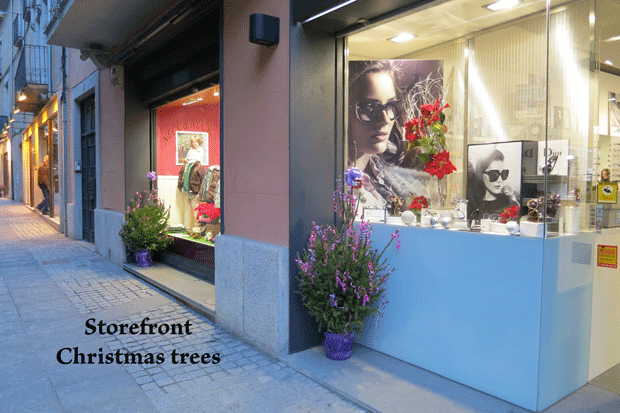
There are brilliant-colored lights strung across the avenues, and a glittering conical abstraction of a Christmas tree pulses on and off in the Plaza de Catalunya. Christmas carols (sometimes in English) echo through the halls, the beauty salons, and the restaurants, and carolers emote as they stroll down the pedestrian Rambla, songbooks in hand. Flame-red poinsettias are for sale in the market, and school-club fundraisers hawk chocolate bars and handmade knickknacks. And there’s the cheery Firanadal (Christmas Fair) offering artisanal goods, felt slippers, jewelry, plastic toys, and boxwood spoons.
Yes, all of this is vaguely familiar, even if gigantes (giant dancing king and queen figures), a marathon Nativity play (Els Pastorets), xuixus (pronounced “choochoos”: sugar dusted, cream-filled pastry rolls), and turrón (a kind of nougat) aren’t usual Christmas fare.
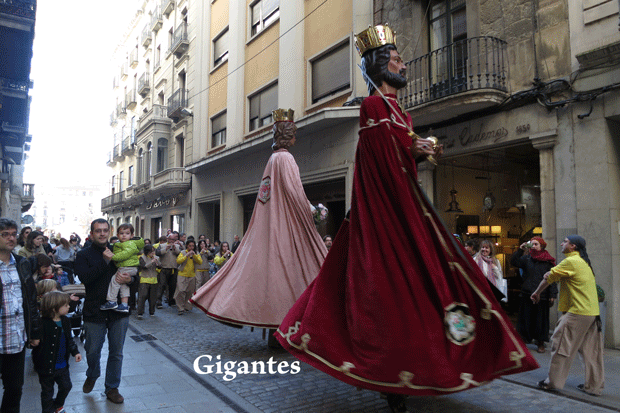
But you really know you’re in a foreign land when you seen the rows of squatting miniature figures—including SpongeBob SquarePants, flamenco dancers, Obama, Barça soccer star Messi, Queen Elizabeth II, and Death—their pants pulled down, a brown plop of poop deposited behind them, for sale for inclusion in Nativity scenes. Correction: the plop of poop behind Death is white, not brown.
by Elyn Aviva
Unwittingly, my husband, Gary, and I walked into an alternative virtual reality. We were surrounded by aliens who looked human. Aliens who spoke a language that sounded like English, but their vocabulary was subtly different. Words like “ROI,” “SEO,” and “hashtags” peppered their speech.
And they communicated with odd body language. Although they seemed to be talking to each other, they rarely made eye contact. Instead, they stared intently at small, vibrating, hand-held devices with brightly lit screens. And they kept tapping these strange pieces of equipment, sometimes with one finger, sometimes with several, or sometimes with their opposable thumbs. Occasionally, their eyes flicked up from the screen to glance around. But only for a moment.
Into what strange world had we wandered? An international travel bloggers conference in Girona, Catalonia, Spain. It sounded appealing in the invitational email: inexpensive, educational, entertaining—and it included a visit to a castle. AND it was taking place in my adopted home town of Girona, so why not?
In this alternative universe, everything was baffling, including the meaning of words I thought I knew. “Relevant” meant “meeting your fans where they’re at” and “content” meant maximizing your Google indexability (the number of searchable key words in your website or blog). “Service” writing” meant providing information and the rush to publish meant some bloggers are posting not weekly but daily or even hourly. A popular book author was called a “long-form print guy.” “Engagement” referred to how actively engaged your Facebook (or blogsite) fan base is, not to a diamond ring.
Genuine or Hoax? Visiting a Crop Circle Formation at Avebury, England
by Elyn Aviva
The news rippled through our group like a breeze through a wheat field: a crop circle had just been spotted! According to a crop circle blog, it had appeared only two days earlier, on the side of Windmill Hill, close to Avebury, in southern England. We were told it was still fresh and relatively untrammeled. Even better news was that we were nearby, since our group was visiting sacred sites in the area—including Stonehenge, Glastonbury, and Avebury, site of the largest stone circle in the UK.
Crop formations usually occur in fields of ripe cereal grains. They appear all over the world but are most prevalent during July and August in the Wiltshire district of southern England. The complex patterns range in size from just a few feet across to over 900 feet, although the average is about 200-300 feet in diameter, and they vary in elements from a few to over 400. The designs may be circular (hence “crop circle”) or based on other geometrical forms (hence “crop formation”).
by Elyn Aviva
We were on Malta, a tiny island at the crossroads of the Mediterranean, within sight on a clear day of Sicily and Mount Etna, and we were confused.
Since our first day on the island, Gary (my husband) and I had been experiencing generalized confusion. For example, we had been told that everyone spoke English—after all, Malta had been an English colony for over 150 years—but street signs were unpronounceable, and our taxi driver didn’t seem to understand a word we said. He replied to our frantic queries in something that sounded like a mixture of Arabic and Italian. And it turns out it was. Sort of. Maltese is a Semitic language, brought by Phoenician settlers 3000+ years ago, so it sounds vaguely Arabic. And because Italy has had such a pervasive influence on Malta—in part because of proximity, and in part because for decades the only television channels available were Italian—Italian words and cuisine are prevalent.

But our linguistic confusion was superficial. Much more confusing were the temples, the fat ladies, and the cart ruts. We had come to Malta to see the massive Neolithic stone temples, recognized by UNESCO as World Heritage Sites. Some of them date back 5,500 years—or maybe 10,000 or 12,000 years, depending on whom you believe. Ggantija, on Malta’s tiny neighbor island Gozo, is thought to be the second oldest temple in the world, after Göbekli Tepe in Turkey. It predates the pyramids by millennia. Some writers believe the Maltese temples are oriented to astrological alignments that existed 12,000 years ago, not 5,500—and might even have been built by extraterrestrials.
In Wales, Nothing is Quite What it Seems
by Elyn Aviva
We were savoring our after-dinner espressos at Llys Meddyg, a “restaurant with rooms,” in Newport, Pembrokeshire, Wales, when my cell phone rang. I looked at it suspiciously.
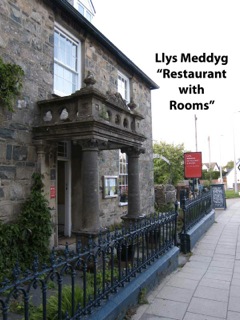 During the week we had stayed at Llys Meddyg the cell phone had never functioned inside the hotel. There simply wasn’t any signal. To make a phone call, I had to walk down the street waving it in the air until gradually the bars started showing up.
During the week we had stayed at Llys Meddyg the cell phone had never functioned inside the hotel. There simply wasn’t any signal. To make a phone call, I had to walk down the street waving it in the air until gradually the bars started showing up.
The phone kept ringing. I answered it and heard a woman’s voice, speaking rapidly. “Hi, this is Winifred. I hear you’re going to write about my land. If you write about my land, you’d better get it right!”
“Hello,” I replied. “How’d you hear about us?”
“My friend David told me. When can we meet?”
The phone suddenly cut out. I ran outside the restaurant and down the street, looking for a signal. One bar, two bars, three. I tried to return the call. It rang once and Winifred answered.
“Sorry, we lost the connection.” I said.
“It’s because of all the volcanic rock in the Preselis. It interferes with cell phone transmissions.”
“So that’s why!” I exclaimed. “I wondered.”
Searching for Sunrise in a Megalithic Cemetery, Ireland
Cautiously, my husband Gary, our friend Michael, and I followed a nearly invisible path through the fog and up the side of Loughcrew hill, just before sunrise. A huge crow—perhaps a raven—flew by, its wings flapping loudly in semi-darkness. We were heading to the ridge top to see a twice-a-year spectacle: the rays of the equinox sunrise penetrating the passageway of Cairn T, a 5,500-year-old megalithic tomb situated 52 miles northwest of Dublin. The equinoxes, which occur around March 21 and September 21, are the two times of the year when the days and nights are of equal length.
by Elyn Aviva
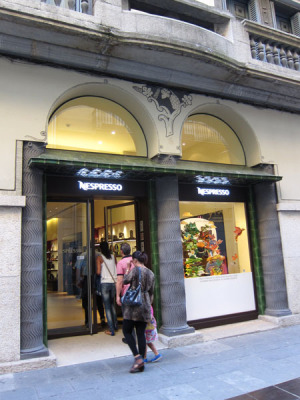 When we went for an early morning stroll in Girona, Catalonia, my husband, Gary, and I saw a group of well-dressed people standing impatiently outside a shop. We took a closer look and saw a storefront with impressive, fluted grey stone columns, large display windows, and imposing glass double doors. The merchandise on display was unusual: small metallic capsules in coordinated colors arranged in geometric designs. Emblazoned in glowing white letters over the doors was “Nespresso.” Nespresso? The coffee capsule brand?
When we went for an early morning stroll in Girona, Catalonia, my husband, Gary, and I saw a group of well-dressed people standing impatiently outside a shop. We took a closer look and saw a storefront with impressive, fluted grey stone columns, large display windows, and imposing glass double doors. The merchandise on display was unusual: small metallic capsules in coordinated colors arranged in geometric designs. Emblazoned in glowing white letters over the doors was “Nespresso.” Nespresso? The coffee capsule brand?
The crowd grew increasingly noisy and impatient. We decided it was time to leave before they became even more restive.
I was puzzled. Who would want to purchase pre-made coffee capsules? It seemed neither cost-efficient nor ecologically sound. And besides, when you ran out, there was nothing you could do—except wait desperately for the Nespresso shop to open.
Returning from our stroll, we paused again at the shop. Nespresso was its name and luxury was its selling point. From our vantage point we could see inside. Slim young women in classy matte-black uniforms stood near the open door, gatekeepers into this exclusive club. People entered, sometimes showed a membership card, chatted for a moment discreetly, and then were ushered into this high temple of gustatory excess.








